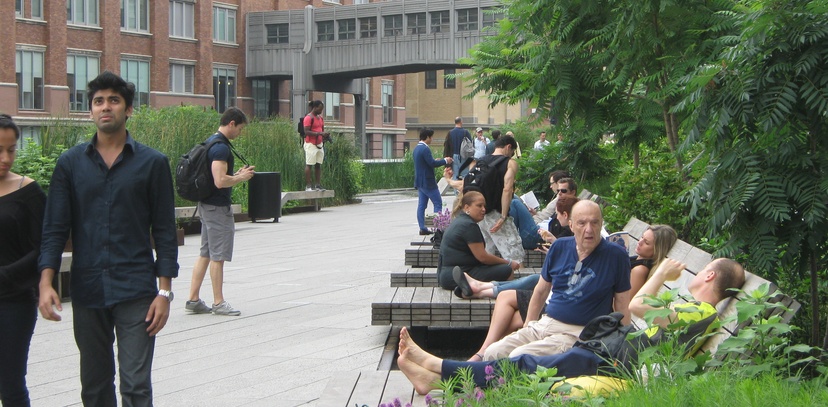
Communities can make things happen in New York City; that seems to be the lesson of the High Line, the fêted public park opened in 2009. But do the dynamics of the park’s creation and management really reflect local community needs and aspirations?
New York City’s most glamorous park, the High Line was opened with a fanfare in 2009 after a remarkably short development process. The park is constructed atop an elevated former-industrial railway running along the West Side of Manhattan from Midtown, down through Chelsea to finish at Gansevoort Street in the Meatpacking District. The railway was opened in 1934, and the last train ran in 1980; between then and the beginning of the redevelopment, naturally seeded plants and flowers begun to grow out of the ballast, creating a miraculous strip of greenery running through the city at 30 feet in the air. It was this unexpected landscape which so captivated Joshua David and Robert Hammond, local residents and co-founders of a group called Friends of the High Line which was established with the intention to preserve and develop the structure. Previously unknown to each other, David and Hammond met at a community meeting organised to debate the future of the railway – it was unpopular with many in the local area, particularly businesspeople. From the beginning, Friends of the High Line’s success in delivering this spectacular project – valorised in the architectural world, adored by visitors – seems to be a lesson in community-led redevelopment. During the course of my master’s degree dissertation research, however, a number of caveats have become clear.
Firstly, Friends of the High Line made a transition from what might loosely be called a community group – a small core of enthusiasts aided by a number of volunteers – to a park conservancy. Highly popular in the USA, conservancies are private organisations with responsibility for managing public park spaces. In this way they are somewhat similar to Business Improvement Districts (BIDs). The question is to what extent does a private organisation with minimal official oversight really reflect the needs of the local community? Indeed, I wonder whether in fact Friends of the High Line might have held a disproportionate amount of power over local redevelopment right from the beginning. Their ability to win over local businesspeople, as well as make connections with key political figures including the City Council Speaker and Michael Bloomberg before he was elected as Mayor, resulted in a coterie with a lot of influence. Does the finished High Line really reflect community interests?
It is a truism to state that Manhattan is starved of open (green) public space. For that reason, any new endowment is likely to be reasonably popular. The park is also extremely safe, with not a single serious crime reported (a good thing for visitors, but perhaps further evidence of the securitisation of public space). Fears have been raised over the High Line’s continuation of that spectre of urban redevelopment, gentrification. The Meatpacking District and Chelsea are already very expensive places to live, and the success of the High Line (and its creation of an extremely robust property submarket) has only increased pressure on those in the area with fewer financial means. There are large public housing projects close by, but there is no guarantee that rent controls will protect the population from the potentially alienating forces of capital.
Regarding the design of the park, it is very limited in terms of what can be construed as ‘traditional’ park use values. There is no play children’s equipment, relatively few places to sit down, and very little shelter from the summer sun. Of course, some of these factors spring from the necessity to develop a very long, narrow space. Even so, the ‘concessions’ to what might reasonably be called community uses expose issues. The only place where visitors can interact with the natural elements of the park, beyond consuming them visually, is at a small lawn opened in June of this year. Yet the lawn is so popular that is has to be closed some of the time in order to preserve it. There is clearly a demand for such spaces, yet the design makes only very limited provision.
A last thing to note is that the long-term sustainability of the private conservancy model of park management is still uncertain. One hundred percent of the High Line’s approximate operating costs of $1m per year are raised privately; as a High Line employee remarked to me, it is much easier to gather donations for the building of a much-hyped, never-before-seen park than for ‘paying the people who pick up trash.’ If this limited amenity does begin to struggle, to what extent can we claim community success on the part of the High Line?
Guest post: Tom Baker – MSc Urban Studies, UCL – @tomalexbaker